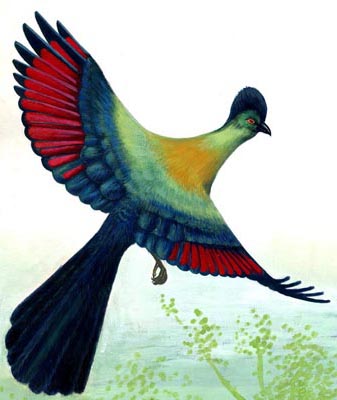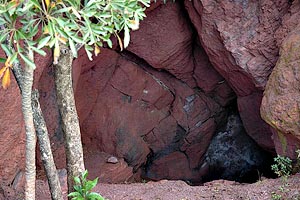The ENTC now has a new website, at www.entc.org.sz
Our logo is adapted from a painting by Phillip Dlamini, 1998, of a purple crested turaco. In traditional Swazi dress, the red feathers feature in the royal headdress, so this bird illustration is not only a symbol for wildlife conservation, but also of cultural heritage.


Many ancient tools were found during initial mining operations in 1964 by the Anglo-American Corporation at the Ngwenya mountain range. When news reached the celebrated archaeologist Professor Raymond Dart in South Africa, he sent Adrian Boshier to investigate.
Boshier found three ancient mines named Lion, Castle and Stag caverns. He collected stone tools in and around them made of dolerite, which is foreign to the area. The tools were unlike those normally found on a stone age site, they were more specialised, consisting of choppers, picks and hammer stones. Professor Dart identified them as mining tools. The tools were not confined to the surface layers but were scattered throughout huge depressions which would have been solid haematite. In one of the mines they were lying among and beneath thousands of tons of red iron oxide known as haematite. Enquiries by Boshier among the Swazis elicited the information that haematite deposits had been mined in historic times and that it was the custom to fill in the excavation to avoid offending the spirits of the underworld. Boshier theorised that if the holes had been refilled with haematite then the mine workers must have wanted something other than haematite.

The high points of the ridge were points named Lion and Castle. Below Castle beacon, Boshier found an adit 13 metres into the mountain and 8 meters at its mouth narrowing vertically to a point. The question was why would people interested in haematite go to all the trouble to mine a material that could easily be got by mining the surface. Specularite (a different ore) was the answer. This form of iron has no surface oxidation and looks much like modern glitter. Specularite is considered to have great power by traditional Swazis and only chiefs and the most qualified priest diviners are permitted to wear it, smearing the whole body and hair with it. In one of the adits they even found a mortar and pestle to grind the specularite. In effect these ancient adits were cosmetic mines producing glitter for ceremonial occasions.

The next question was how old were these mines? The archaeologist, Peter Beaumont, produced evidence of mining in the Middle Stone Age, Late Stone Age and Iron Age. At Ngwenya, Middle Stone Age people tunnelled adits into the precipitous western face in search of iron pigments, weathered haematite (libomvu) near the surface, and the deeper and harder black glistening form, specularite (ludumare). In 1967 charcoal nodules from some of the more ancient adits were sent to both Yale and Groningen radiocarbon laboritories where Carbon 14 testing was carried out. A date of about 41 000 BC was obtained, making this the oldest known mining operation in the world. However this is the extreme range of carbon dating, the mines may be older than this date. It is thought these ores were mined until at least 23 000 BC. At Lion Cavern it is estimated that at least 1 200 tons of soft haematite ore, rich in specularite, had been removed in ancient times.
Despite the enormous amounts of ore which must have been removed, no traces of iron smelting have been located in the Ngwenya area. This is probably because smelting ore required large volumes of heavy wood. It was easier to carry the ore to the wood, which occurred on stream and river banks in the valleys, than to carry the wood up the mountain to the ore.
The finds have also synthesised our understanding of the origins of ceremony and symbology. In the Swaziland mine the excavators found the skeleton of a child buried at least 50 000 years ago, together with a perforated sea shell pendant, early evidence of personal adornment suggesting aesthetic appreciation for Homo sapiens.
Unfortunately these ancient relics are not in Swaziland. Excavation took place before Swaziland's independence when there was no museum and most are housed in the McGregor Museum in Kimberley.
In around 400 to 450 AD black settlers moved down Africa and entered southern Africa, including Swaziland. They brought with them a new way of life that gradually replaced the stone age life of the Bushmen culture. They grew crops, had domestic animals and made iron weapons. Previously Ngwenya had been mined for specularite and ochre. When the black settlers arrived they continued these traditions but added one of their own - mining ore to smelt and make domestic implements and weapons.
The new mining took the form of huge quarries extending over about 12 hectares on the mountaintop platform at Ngwenya. It is estimated that from just one of these quarries 2 000 tons of 'soft' red haematite ore had been removed. These quarries were removed in the course of modern mining, but C14 dates obtained beforehand place the beginnings of iron ore mining at about 400 AD although it is thought that ancient opencast mines date to about 2 000 BC during the Late Stone Age. It is known that iron ore mining at Ngwenya continued to supply ore for smelting until cheap imported iron from Europe made the effort no longer worthwhile, probably in the late nineteenth century.
Castle Cavern was processed during mining operations, but the ancient mine at Lion Cavern may be visited accompanied by a game ranger from the reserve. There is a visitor center at the mine with educational displays on the history of the mine.
Modern Exploitation - see Malolotja Iron Mines and Malolotja Gold Mines
Our Contacts:
Head Quarters: (+268) 2416 1489/1179
Email: info@sntc.org.sz
King Sobhuza II Park: (+268) 2416 1489/1179
Email: ksmp@sntc.org.sz
National Museum: (+268) 2416 1489/1179
Email: curator@sntc.org.sz
Copyright © ESWATINI NATIONAL TRUST COMMISSION
Malolotja Nature Reserve: (+268) 2444 3241 / (+268) 2416 1480
Email: culturalvillage@sntc.org.sz
Mantenga Nature Reserve and Swati Cultural Village: 2416 1151/1178
Email: culturalvillage@sntc.org.sz
Mlawula Nature Reserve: (+268) 2383 8885 (Reception)
(+268) 2383 8453 (Senior Warden)
Email: culturalvillage@sntc.org.sz
Magadzavane Lodge: (+268) 2343 5108/9
Email: magadzavane@sntc.org.sz